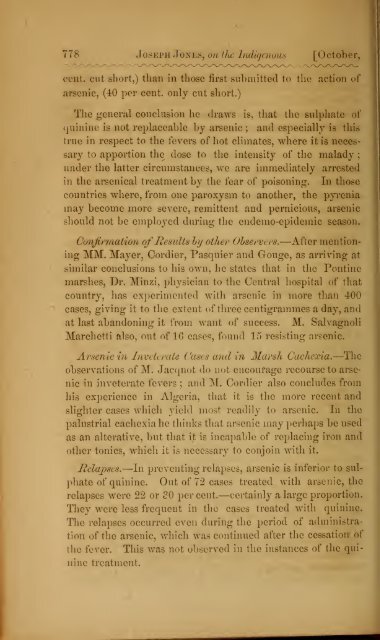<strong>1861</strong>.] Renu the Southern Confederacy. 777been efficacious as 1, the sulphate of quinine as three and afraction.The arsenic without emetic has cut short the lever vtimes per cent.; the sulphate of quinine without emetic, 49.52times per cent.;the proportion being arsenic as l,to sulphateof quinine as 5 and a fraction. Lastly, in comparing thea the most favorable to the arsenic, viz.: those in which itwas administered in large doses, three to ten centigrammes,accompanied by emetics, and a diet whose only limit was thea<strong>pp</strong>etite of the patient, with the cases least favorable to thequinine, we arrive at the following results :Fcvcr< cut short by arsenic, - - - 9.6S per cent.•quinine, - - 49.52 " "As respects the cases not cut short, it will be perceived, onreferring to the first four iigures of the two verticalcolumnsof the table, that in the instance of the fevers treated withquinine, the numbers arc smaller and smaller, according aswe examine the categories of cases more and more refractory,whilst the contrary is noticed in the instance of the arsenicaltreatment. The contrast is perfect.In about 35 cases it was possible to compare the effects ofthe quinine and arsenic, the two medicines having been administeredin succession to the same patient, either for thesame fever, or in two separate attacks. In a sixth of thesenical and quinine treatment were of little efficacy:in another sixth, the two medications were followed by: in the four other sixths, the sulphate of quinineshowed itself the most active, or the only active remedy ofthe two ;and one observation furnished a very marked instanceof fever resisting the sulphate of quinine, and cured bymic. In short, the author concludes that we see morers which resist arsenic, yielding to quinine, than we dofevers, refractory to quinine, disa<strong>pp</strong>earing under arsenicaltreatment. lie believes, also, that h< ablished the factof the greater activity of the sulphate of quinine in the caseswhich have received no previous arsenical treatment (T>4 per
778 Joseph Jones, on the Indigenous [<strong>October</strong>,cent, cut short,) than in those first submitted to the action ofarsenic, (40 per cent, only cut short.)The general conclusion lie draws is, that the sulphate ofquinine is not replaceable by arsenic ; and especially is thistrue in respect to the fevers of hot climates, where it is neesary to a<strong>pp</strong>ortion the dose to the intensity of the malady ;under the latter circumstances, we are immediately arrestedin the arsenical treatment by the fear of poisoning.In thosecountries where, from one paroxysm to another, the pyreniamay become more severe, remittent and pernicious, arsenicshould not be employed during the endemo-epidemic season.Confirmation of Results by other Observers.—After mentioningMM. Mayer, Cordier, Pasquier and Gouge, as arriving atsimilar conclusions to his own, he states that in the Pontinemarshes, Dr. Minzi, physician to the Central hospital of thatcountry, has experimented with arsenic in more than 400cases, giving it to the extent of three centigrammes a day, andat last abandoning it from want of success. M. SalvagnoliMarchetti also, out of ID cases, found 15 resisting arsenic.Arsenic in Inveterate Cases and inMarsh Cachexia.—Theobservations of M. Jacqnot do not encourage recourse to arsenicin inveterate fevers ;and M. Cordier also concludes fromhis experience in Algeria, that it is the more recent andslighter cases which yield most readily to arsenic. In thepalustrial cachexia he thinks that arsenic may perhaps be usedas an alterative, but that it is incapable of replacing iron andother tonics, which it is necessary to conjoin with it.IZelajiscs.—In preventing relapses, arsenic is inferior to sulphateof quinine. Out of 72 cases treated with arsenic, therelapses w r ere 22 or 20 percent.—certainly a large proportion.They were less frequent in the cases treated with quinine.The relapses occurred even during the period of administrationof the arsenic, which was continued after the cessation ofthe fever.This was not observed in the instances of the quininetreatment.
- Page 1 and 2: SOUTHERNfttcMcai avto Surgical Imtt
- Page 3 and 4: practical754 i;i'Ji J'oXes, on the
- Page 5 and 6: 756 Joseph Jones, on the Indigenous
- Page 7 and 8: ;7 58 Joseph J ones, on the Indigen
- Page 9 and 10: 760 Joseph Jones, on the Indigenous
- Page 11 and 12: 762 3EPflJoKfis, bn the Indigenous
- Page 13 and 14: 764 Joseph Jones, on the Indigenous
- Page 15 and 16: 7'!
- Page 17 and 18: —'.emeticssbfhJohi[Octobameliorat
- Page 19 and 20: 770 Joseph Jones, on the Indigenous
- Page 21 and 22: 77-? Joseph Jones, on the Indigenou
- Page 23 and 24: 7 74 Joseph Jones, on the Indigenou
- Page 25: 776 Joseph Jones, on 1 the Indigeno
- Page 29 and 30: 780 Joseph Jokes, on (he Indigenous
- Page 31 and 32: 782 Joseph Jones, on the Indigenous
- Page 33 and 34: :784 Joseph Jones, on the Indigenou
- Page 35 and 36: —786 Joseph Jones, on the Indigen
- Page 37 and 38: 788 Dvphtlima. [October,to confound
- Page 39 and 40: 700 Diphtheria. [October,*almost in
- Page 41 and 42: 792 Diphtheria. [October,in water a
- Page 43 and 44: 704 Diphtheria: [October,find favor
- Page 45 and 46: 796 Diphtheria. [October,tongue. \)
- Page 47 and 48: 798 Uterine Inflammation. October,b
- Page 49 and 50: 800 Uterine Inflammation. [October,
- Page 51 and 52: 802 Uterine Inflammation. [October,
- Page 53 and 54: elhrai804 me Inflammation. [October
- Page 55 and 56: ;806 Phlegmasia Dolens. [October,Th
- Page 57 and 58: SOS Termination ofNerves. [October,
- Page 59 and 60: cl Termination of Nerv October,] to
- Page 61 and 62: —812 Development of Bloodvessels.
- Page 63 and 64: —814 ( orpuscles of the Spleen. [
- Page 65 and 66: —Mi; Ammomcemh. [October,tubes in
- Page 67 and 68: 818 Ammoniamia. [October,v^^%/\yof
- Page 69 and 70: 820 Arnmoniccraia. [October,combine
- Page 71 and 72: 822 Ammonicemia, [October,all, requ
- Page 73 and 74: 824 Galcano Cautery in Cataract. [O
- Page 75 and 76: —826 Editorial. [October,MEDICAL
- Page 77 and 78:
———828 Miscellaneous. [Octobe
- Page 79 and 80:
———830 Miscellaneous. [Octobe
- Page 81:
—832 Miscellaneous.was employed f








